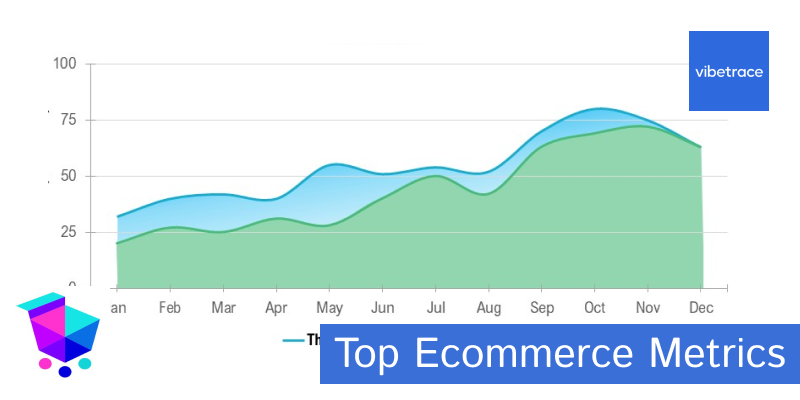There are many eCommerce metrics available on the internet, but not all of them will be useful to your business, so don’t get overwhelmed. But what are the top ecommerce metrics?
You are not required to use all metrics because the key to a successful business is having a thorough understanding of the most useful eCommerce metrics.
Interested in the whole list of metrics definitions?
These metrics will undoubtedly help you decide what your next steps should be for your marketing efforts to improve your business and achieve its objectives.
In this article, you’ll learn the top 8 e-commerce metrics that have been proven to be effective in tracking your business’s progress.
What is an eCommerce metric?
An eCommerce metric is defined as a measurement or key performance indicator (KPI) used to evaluate and assess the performance and effectiveness of an eCommerce business.
These metrics can help you track various aspects of the online shopping experience of users, customer behavior, and business operations in the digital realm, which are essential for understanding the success of your online store, identifying areas for improvement, and making data-driven decisions to optimize your business performance.
Moreover, there is a long list of available eCommerce metrics, but the ability to understand a few important metrics that are relevant to your business can help you achieve your objectives.
How to Measure E-commerce Success
There is no guarantee of success for every eCommerce business, but there are ways to keep track of how well your business is doing.
Your main goal as an eCommerce business owner is to sell, but being able to sell doesn’t always necessarily mean that you are earning enough.
This is why you need to use analytics to understand specific areas of your business, especially the conversion and retention of customers. This will provide you with insight that will also help you make appropriate decisions about your business processes or marketing strategies.
How to determine which e-commerce metrics matter for your business
As an eCommerce owner, you probably already know who your target audience is, so by studying their interests and activities, you could be able to determine the kind of metrics that you will need for your business.
You may start with at least four metrics and increase them as needed. Also, it is important to know that some metrics may actually have the same result and will only confuse you if you use them at the same time.
To help you decide the best metrics that are perfect for your e-commerce business, here we will share with you the top metrics you shouldn’t miss out on!
Top 8 E-commerce Metrics
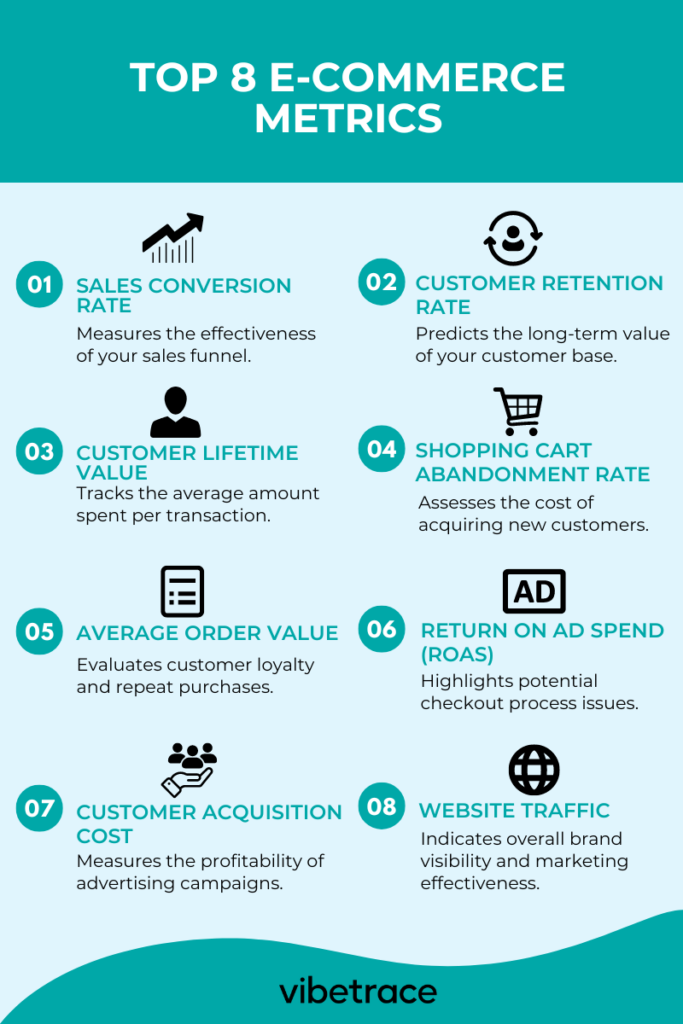
Sales Conversion Rate
The sales conversion rate is a metric that measures the percentage of website visitors or potential customers who complete a desired action, such as making a purchase, subscribing to your newsletter, downloading a file on your website, or even sharing your content.
This metric can help you gauge the effectiveness of your marketing and sales efforts in turning leads into customers.
Conversion rate can either be achieved by converting a new visitor to purchase your best offer or by persuading a previous customer with products available for them.
However, conversion rates vary by business industry and model.
So, if you really want to have a high conversion rate, then you must keep in mind a few important things that will help you convert more people, such as:
- Use of high-quality content and images
- Use of the right and competitive price for products
- A strong call to action (CTA)
- Website free from errors and runs smoothly
- The website provides good user experience
In addition to this, you must provide people with an irresistible offer.
Customer Lifetime Value
Your customers must not just be one-time customers, and you shouldn’t think of them that way. Building a relationship with a customer is cheaper than acquiring new customers all the time.
This is why you need to keep track of your customer’s lifetime value.
Customer lifetime value (CLV) is defined as a metric that calculates the projected revenue a customer is expected to generate over the entire duration of their relationship with a business.
In simple terms, it is the amount of revenue you get from one customer throughout their customer journey with your brand.
Moreover, it considers factors such as the average purchase value, purchase frequency, and customer retention rate, providing insights into the long-term profitability of each customer.
In order to increase your CLV, you should make sure you incorporate these four things:
- Investment for Client Retention
- Loyalty programs
- Social Media Marketing
- Email Marketing
Keep an eye on this metric, and you will surely generate more repeat purchases in the long run.
Average Order Value
The average order value (AOV) is the average amount spent by customers on an e-commerce website in a single transaction.
To optimize your AOV, you must know your target audience well so you can provide them with the best experience with your brand by offering them what they really need.
Monitoring the AOV can help your business understand customer spending patterns and help you decide on your next strategies to increase revenue, such as upselling or cross-selling.
In addition to that, there are a few more things you can do to improve your AOV, such as:
- Provide free shipping voucher for minimum order/sum
- Offer personalized vouchers for the next orders
- Limited time offer products
Take note to track AOV from different channels and devices to see how you could gain more, then adjust your strategies afterward.
Do you like this article?
Join our CX for Retail dedicated newsletter!

Stay connected to what’s really important to optimize your digital revenues.
By clicking the button, you accept our Terms & Conditions. Also you will need to confirm your email address.
Customer Acquisition Cost
If you are just starting your business, there’s no doubt that acquiring consumers is going to be expensive, but by tracking your customer acquisition cost, you’ll be able to identify if your marketing efforts are paying off or if people’s responses have a positive impact on your business.
By definition, customer acquisition cost (CAC) refers to the amount of money a business spends on average to acquire a new customer.
It is also often described as a ‘startup killer metric’ because marketing campaigns can provide only a minimal return, which can ultimately hinder a company’s ability to survive.
CAC includes your marketing expenses, sales team salaries, and any other costs associated with acquiring more customers.
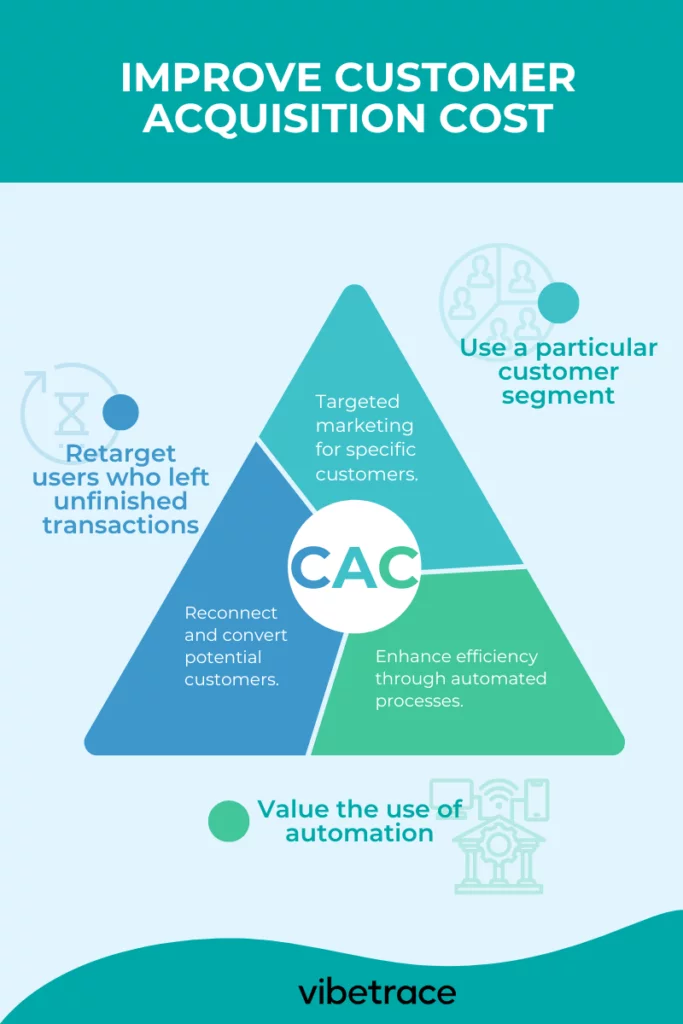
There might be a lot of tips and tricks available, but not all could work for your business. To help you improve your CAC, try these three things:
- Use a particular customer segment
- Retarget users who left unfinished transactions
- Value the use of automation
In addition, you can evaluate the profitability of your acquisition efforts by comparing them to your customer’s lifetime value.
Customer Retention Rate
Assessing customer loyalty and satisfaction is very important for your business.
This is how you build trust and gain more consistency from customers who buy from your brand.
As most marketing experts say, the ability to understand your customer retention rate can help you decrease churn and increase loyalty.
The customer retention rate measures the percentage of customers who continue to do business with a company over a specified period.
A high retention rate indicates that customers are satisfied with the products or services and are likely to make repeat purchases, leading to increased revenue.
Furthermore, this metric can alert you to opportunities to improve your customer service because most people who stay with a brand do so for this reason, and one bad experience can be the reason why a customer does not return.
Lastly, make sure to request customer feedback because you can get more ideas from them on what to improve.
Shopping Cart Abandonment Rate
Abandoned carts by potential customers may look like negative feedback, but the truth is there is a positive side to it.
This will allow you to retarget consumers and better understand what they might want and need. They probably just need a little push from your business to make them feel valued.
If you are wondering what the shopping cart abandonment rate is, it is the percentage of customers who add items to their online shopping carts but leave the website without completing the purchase.
It is a critical metric that reflects the effectiveness of your business website’s checkout process, pricing strategy, and overall user experience.
Lowering the abandonment rate can significantly improve e-commerce sales.
Return On Ad Spend (ROAS)
As a business owner, you need to determine the return on investment (ROI) from your marketing efforts.
So, tracking ROAS is required because it could help you optimize your strategies to achieve a good and high ROAS.
Return on ad spend (ROAS), by definition, is a metric that measures the effectiveness of advertising campaigns by evaluating the revenue generated compared to the amount spent on advertisements.
Moreover, an acceptable ROAS is influenced by profit margins, operating expenses, and the overall health of the business.
This metric is such a powerful indicator that will guide you to make informed decisions on how to use your dollars in advertising that generates revenue for your business. Although this does not necessarily shows the profitability of your overall net profit margin.
Website Traffic
The most simple and easiest metric to track is your Website Traffic.
It is crucial to monitor the number of visitors regularly accessing your website or eCommerce shop, regardless of whether it is a result of your marketing efforts or not.
Tracking website traffic provides valuable insights into the effectiveness of your marketing campaigns, content strategies, and user engagement.
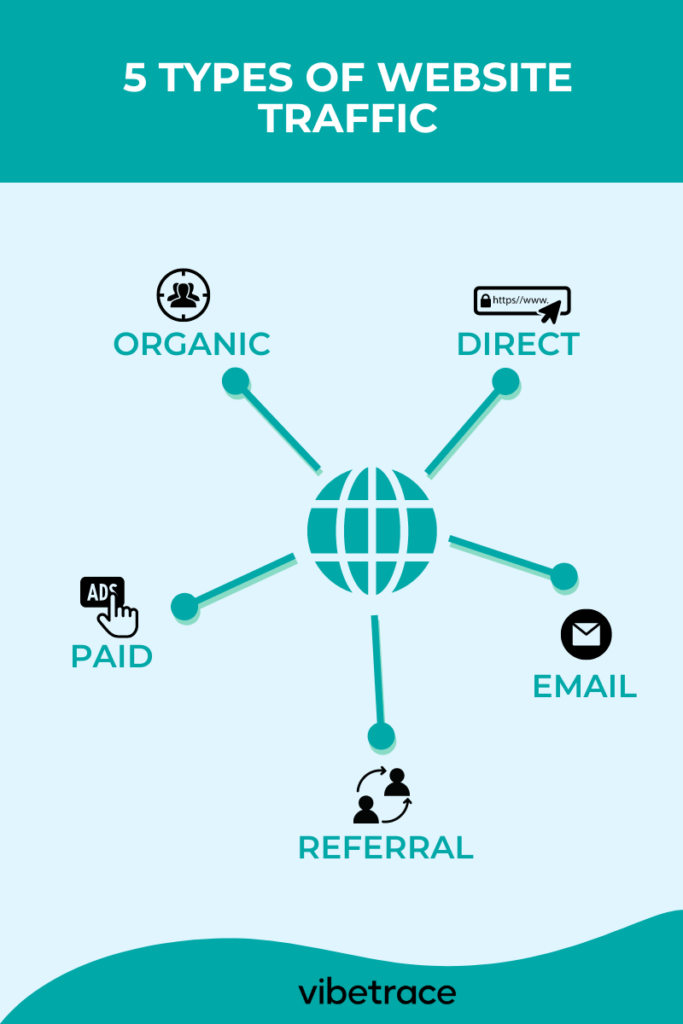
By analyzing traffic sources, you can identify the most successful channels, such as social media and email marketing, for driving visitors to your website and optimize your marketing efforts accordingly.
How Often Should I Check My E-commerce Metrics?
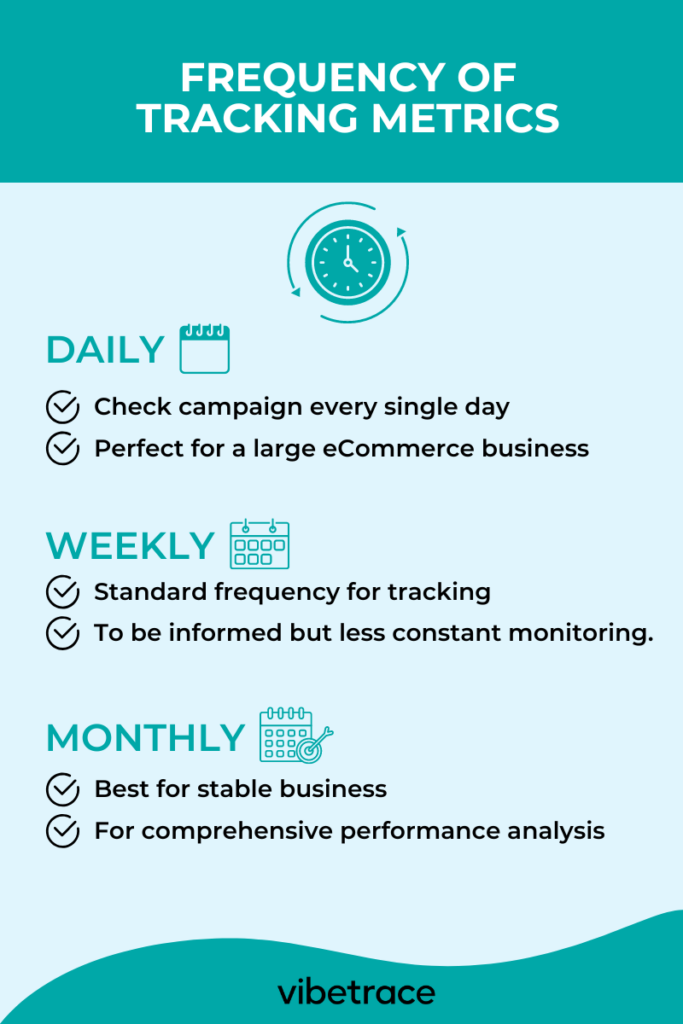
You probably have asked yourself “How often should I check my e-commerce metrics?”
And due to tons of advice available online, you might already have some thoughts in your mind but the truth is there’s no perfect answer to this question because” it depends.”
The frequency of tracking these metrics depends on the goals, objectives, type, size, and other needs of your business.
Daily
If you are just starting out your eCommerce store, it is best to check the overall health of your business so you could Identify the potential success of the business.
But if you have a large eccomerce store, you may also track eCommerce metrics daily so you won’t be overwhelmed with so many transactions to track.
Additionally, if your business requires real-time data to be advertised every day to send information the tracking daily will allow you to check how well your campaign is doing within a single day.
This allows you to promptly identify issues, track customer behavior, and make immediate adjustments to optimize your e-commerce performance.
Weekly
Daily tracking is not always beneficial unless you have a large number of campaigns to monitor in order to determine your company’s return on investment.
Many businesses routinely check their e-Cmmerce metrics on a weekly basis.
You can use this to make a good balance between staying informed and minimizing constant monitoring.
Bi-weekly or Monthly
Checking e-commerce metrics on a biweekly or monthly basis can suffice your business with stable operations or limited resources for frequent monitoring.
This timeframe allows you for a more comprehensive performance analysis, pattern identification, and strategic decision-making based on a larger set of data.
Take your First Step
Ideally, you will need the right software to track the following metrics.
This is the first step to take to make sure that you are on the right track.
Vibetrace includes features that will provide your company with valuable insights and metrics to help you optimize your online sales and marketing strategies.
It provides a variety of tools and features to assist you in better understanding your customers, increasing conversions, and increasing revenue.
Vibetrace also integrates with popular e-commerce platforms like Shopify, Magento, WooCommerce, and others.
Look no further because Vibetrace is a valuable solution for your company seeking a competitive advantage in the online marketplace.

